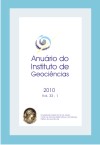Benthic foraminifera and bacterial activity as a proxy for environmental characterization in Potengi Estuary, Rio Grande do Norte, Brazil
DOI:
https://doi.org/10.11137/2010_1_20-34Abstract
The aim of this study was to identify possible zonation patterns and assess the environmental impact on the Potengi River Estuary, Rio Grande do Norte State, through the distribution of benthic foraminifera associated to bacterial activity and abiotic parameters. Six sediment samples were collected from locations that presented clear signs of pollution. The environment was predominantly anaerobic and fermentation occurred at all sites. Forty-two species of foraminifera were identified. The dominant species were Ammonia tepida and Arenoparrella mexicana, which are known to be opportunistic, and able to adapt to rapidly changing conditions. CCA analyses showed that salinity and organic matter, followed by bacterial carbon, were more strongly linked to organism distribution in the Potengi River Estuary. Dissolved oxygen concentration, temperature and total organic matter were higher at the estuary mouth than at the other sites, creating favorable conditions for foraminiferal growth and allowing the faunistic succession on the upper estuary. As foraminifera assemblages when associated to environmental parameters can be used as efficient proxies for environmental diagnosis, these results suggest that the Potengi Estuary is under great stress from the surrounding urban development.Downloads
Download data is not yet available.
Downloads
Published
2010-06-01
How to Cite
Souza, V. M. de (2010) “Benthic foraminifera and bacterial activity as a proxy for environmental characterization in Potengi Estuary, Rio Grande do Norte, Brazil”, Anuário do Instituto de Geociências. Rio de Janeiro, BR, 33(1), pp. 20–34. doi: 10.11137/2010_1_20-34.
Issue
Section
não definida
License
This journal is licensed under a Creative Commons — Attribution 4.0 International — CC BY 4.0, which permits use, distribution and reproduction in any medium, provided the original work is properly cited.















